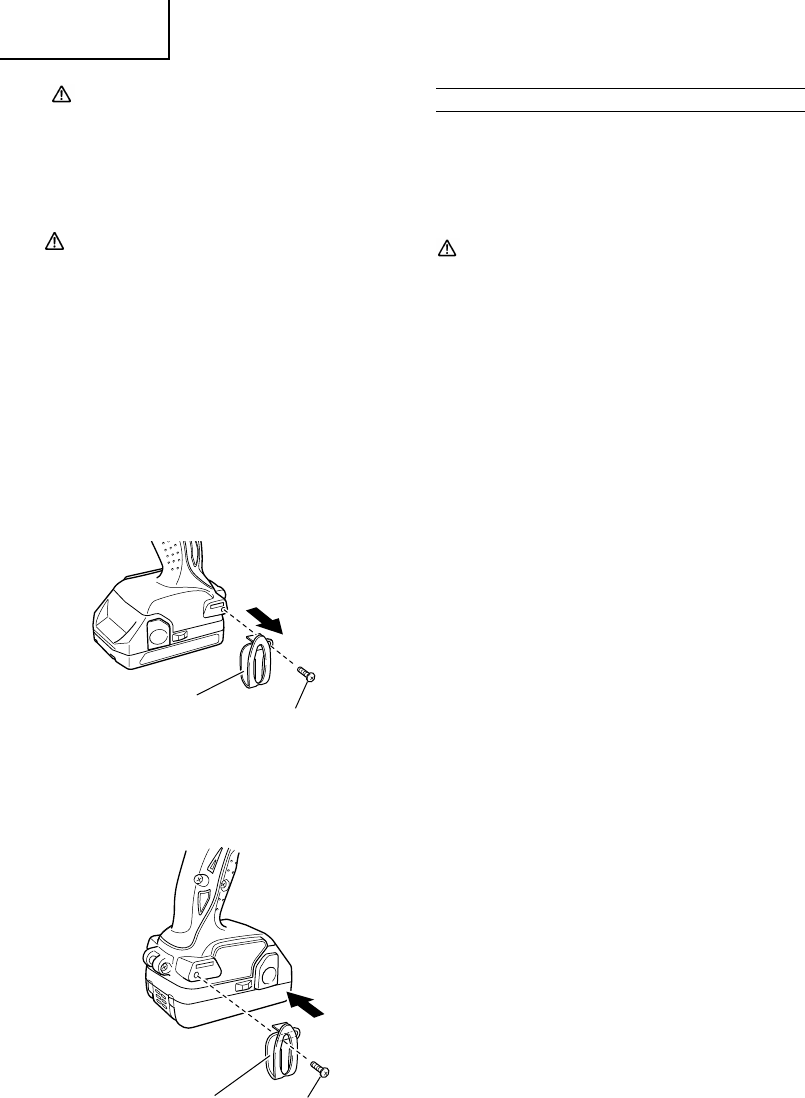
English
14
CAUTION:
Do not look directly into the light. Such actions
could result in eye injury.
9. Using the hook
The hook is used to hang up the power tool to your
waist belt while working.
CAUTION
ⅷ
When using the hook, hang up the power tool
firmly not to drop accidentally.
If the power tool is dropped, it may lead to an
accident.
ⅷ
When carrying the power tool with hooked to your
waist belt, do not fit any bit to the tip of power
tool. If the sharp bit such as drill is fitted to the
power tool when carrying it with hooked to your
waist belt, you will be injured.
ⅷ
Install securely the hook. Unless the hook is securely
installed, it may cause an injury while using.
(1) Removing the hook.
Remove the screws fixing the hook with Philips
screw driver. (Fig. 8)
Fig. 8
(2) Replacing the hook and tightening the screws.
Install securely the hook in the groove of power
tool and tighten the screws to fix the hook firmly.
(Fig. 9)
Fig. 9
OPERATIONAL CAUTIONS
1. Resting the unit after continuous work
After use for continuous bolt-tightening work, rest
the unit for 15 minutes or so when replacing the
battery. The temperature of the motor, switch, etc.
will rise if the work is started again immediately after
battery replacement, eventually resulting in burnout.
CAUTION:
Do not touch the metal parts, as it gets very hot
during continuous work.
2. Cautions on use of the speed control switch
This switch has a built-in, electronic circuit which
steplessly varies the rotation speed. Consequently,
when the switch trigger is pulled only slightly (low
speed rotation) and the motor is stopped while
continuously driving in screws, the components of
the electronic circuit parts may overheat and be
damaged.
3. Use a tightening time suitable for the screw
The appropriate torque for a screw differs according
to the material and size of the screw, and the material
being screwed etc., so please use a tightening time
suitable for the screw. In particular, if a long
tightening time is used in the case of screws smaller
than 5/16” (8 mm), there is a danger of the screw
breaking, so please confirm the tightening time and
the tightening torque beforehand.
4. Work at a tightening torque suitable for the bolt
under impact
The optimum tightening torque for nuts or bolts
differs with material and size of the nuts or bolts.
An excessively large tightening torque for a small
bolt may stretch or break the bolt. The tightening
torque increases in proportionate to the operation
time. Use the correct operating time for the bolt.
5. Confirm the tightening torque
The following factors contribute to a reduction of
the tightening torque. So confirm the actual
tightening torque needed by screwing up some bolts
before the job with a hand torque wrench. Factors
affecting the tightening torque are as follows.
(1) Voltage
When the discharge margin is reached, voltage
decreases and tightening torque is lowered.
(2) Operating time
The tightening torque increases when the operating
time increases. But the tightening torque does not
increase above a certain value even if the tool is
driven for a long time.
(3) Diameter of bolt
The tightening torque differs with the diameter of
the bolt. Generally a larger diameter bolt requires
larger tightening torque.
Hook
Screw
Screw
Hook
01Eng_WH18DSAL_US 1/9/09, 11:3514


















